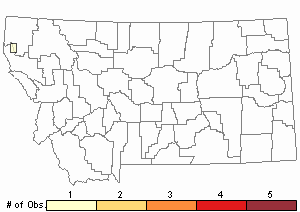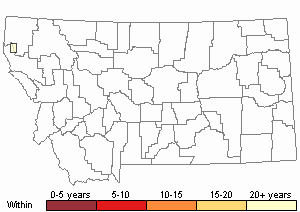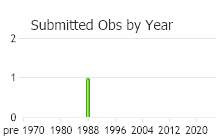View in other NatureServe Network Field Guides
NatureServe
Montana
Utah
Wyoming
Idaho
Wisconsin
British Columbia
South Carolina
Yukon
California
New York
Star Hair Peatmoss - Sphagnum girgensohnii
Other Names:
Girgensohn's Peatmoss
General Description
Plants: Forming uncrowded carpets (Crum and Anderson et al. 1981), medium in size to coarse and vigorous, slender and quite rigid, occasionally thicker, usually a deep green in shady habitats to somewhat ochre in more exposed areas; capitulum conspicuous, level-topped (FNA 2007), and 5-radiate (Crum and Anderson et al. 1981).
Stems and Stem Leaves: Stems light green to ochre. Stem leaves tongue-shaped or widely so, 0.8-1.3 mm in length; apex wide, somewhat squared off, appearing quite tattered and torn for about ¾ of the apex width (FNA 2007).
Branches and Branch Leaves: Branch stems green, long and narrowing gradually, dimorphic, occurring in clusters of 2 wider, longer spreading and 1-2 narrower pendent branches. Branch leaves egg-shaped or tending toward lance-shaped, mostly 1-1.4 mm in length, occasionally a little longer, straight, slightly cupped; margins smooth; apex strongly rolled upward and inward (FNA 2007).
Stem and Stem Leaf Cells: Stem cortical cells fine-walled, swollen, lacking fibrils, and with 1 large pore at the upper end. Hyaline cells of the stem leaves unevenly 4-sided, lacking fibrils, seldom divided with cross-walls, largely reassimilated on the inner leaf surface and generally intact on the outer surface (FNA 2007).
Branch and Branch Leaf Cells: Retort cells of the branch stem either individual or in clusters of 2 or 3, the necks somewhat evident. Hyaline cells of the branch leaves with numerous pores along the margins adjacent to the green cells on the convex leaf surface, the elliptic pores small distally on the leaf, becoming larger proximally, and displaying on the concave surface bigger and rounded pores beside the leaf margins and base; green cells deltoid to trapezoidal in X-section, showing on both leaf surfaces, more widely so on the concave side, the end walls of the cells not great in depth (FNA 2007).
Phenology
Capsules ripen at the end of summer (FNA 2007).
Diagnostic Characteristics
The green shade and large, thin, well-defined radiating capitulum distinguish this species except in the far north of its distribution, where it is frequently brown with golden tones, and forms more compact carpets (FNA 2007).
Range Comments
In North America: Present in all provinces and territories of Canada; in the USA found in the PNW states, CA and CO, also in most of the northeastern states extending s to NC and TN, and w to IL, WI, MN and ND (FNA 2007). Known in Montana from Lincoln and Madison Counties (Elliott 2016).
Observations in Montana Natural Heritage Program Database
Number of Observations: 1
(Click on the following maps and charts to see full sized version)
Map Help and Descriptions
Relative Density

Recency


 (Observations spanning multiple months or years are excluded from time charts)
(Observations spanning multiple months or years are excluded from time charts)
Habitat
Almost always in wooded habitats on moist soil (Vitt 1988), peat (Elliott 2016), and beside streams, able to withstand shade, forming carpets (FNA 2007).
Reproductive Characteristics
Dioicous. Sporophytes infrequent (FNA 2007).
Stewardship Responsibility
References
- Literature Cited AboveLegend:
 View Online Publication
View Online Publication Elliott, J.C. and A.K. Pipp. 2018. A Checklist of Montana Mosses (1880-2018). Updated 3 January, 2020. Montana Natural Heritage Program, Helena, Montana. 73 pp.
Elliott, J.C. and A.K. Pipp. 2018. A Checklist of Montana Mosses (1880-2018). Updated 3 January, 2020. Montana Natural Heritage Program, Helena, Montana. 73 pp.
- Additional ReferencesLegend:
 View Online Publication
View Online Publication
Do you know of a citation we're missing? Elliot, J. C. 1993. Second checklist of Montana mosses. Unpublished report. U.S. Forest Service, Region 1. Missoula, MT. 45 pp.
Elliot, J. C. 1993. Second checklist of Montana mosses. Unpublished report. U.S. Forest Service, Region 1. Missoula, MT. 45 pp. Lawton, E. 1971. Keys for the Identification of the Mosses on the Pacific Northwest. Reprinted from 'Moss Flora of the Pacific Northwest'. Published as Supplement No. 2 of the Journal of the Hattori Botanical Laboratory. Nichinan, Miyazaki, Japan. 66 pp.
Lawton, E. 1971. Keys for the Identification of the Mosses on the Pacific Northwest. Reprinted from 'Moss Flora of the Pacific Northwest'. Published as Supplement No. 2 of the Journal of the Hattori Botanical Laboratory. Nichinan, Miyazaki, Japan. 66 pp. Lawton, E. 1971. Moss Flora of the Pacific Northwest. Hattori Botanical Laboratory. Japan: Yamabuki-cho, Shinjuku-ku, Tokyo. 362 pages plus appendices.
Lawton, E. 1971. Moss Flora of the Pacific Northwest. Hattori Botanical Laboratory. Japan: Yamabuki-cho, Shinjuku-ku, Tokyo. 362 pages plus appendices.
- Web Search Engines for Articles on "Star Hair Peatmoss"





